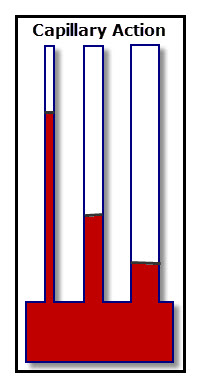 Capillary Action is also called wicking, which is the ability of a substance to draw another substance into it.
Capillary Action is also called wicking, which is the ability of a substance to draw another substance into it.
In the diagram, three different size glass tubes are standing in a container of colored water. Notice that the water rises to a different height in each of the tubes. The more narrow the tube, the higher is the water.
Question: Why does the water rise in the tubes?
Answer: First we need to identify two types of attractions between molecules.
1. Adhesion: The attraction between unlike molecules. For example, water molecules and glass molecules.
2. Cohesion: The attraction between like molecules. Two examples are: the attraction between water molecules and the attraction between glass molecules.
The water rises in the glass tubes when the adhesion between the water molecules and glass molecules is greater than the cohesion between the water molecules. This movement of water is called capillary action.
IN THE REAL WORLD
Capillary action is part of the reason that water rises in a plant stem and moves throughout the plant. The water enters the plant’s roots and moves to other parts of the plant through tiny tube-like structures called xylem. Xylem are part of the plants transpiration system, through which nutrients, including water, are transported throughout the plant.

The leaves of the celery take on a reddish color because the red water moves through xylem tubes of the celery. This movement is called capillary action, which is one part of the plants transpiration system.
Discover for Yourself
1. Fill a plastic cup about one-fourth full with water. Add about ten drops of red food coloring and stir.
2. Select an inner stalk of celery. You want one that has pale green leaves.
3. Use scissors to cut across the end of the celery stalk. Observe and make note of the color of the cut end of the celery stalk. Also make note of the color of the leaves on this stalk.
4. Stand the celery stalk, cut end down, in the red water.
5. Observe the color of the color of the leaves on the celery stalk periodically for two or more days.
Results: The pale green leaves take on a reddish color.This is because the red coloring dissolved in the water and moved with the water through the xylem tubes in the celery stalk and leaves The red coloring was deposited in the leaves, but most of the water evaporated through tiny opening in the leaves. The evaporation of the water from plants is called transpiration. This evaporation of the surface water from the xylem tubes results in more water being pulled into the roots to keep the xylem tubes filled. Thus, there is a continued movement of water through the plant.
Note: Nutrients in the soil that dissolve in water are transported to the cells in plants in a similar way that the red coloring was transported to the leaves of the celery.
 |
Janice VanCleave’s Plants: Mind-Boggling Experiments You Can Turn Into Science Fair Projects |